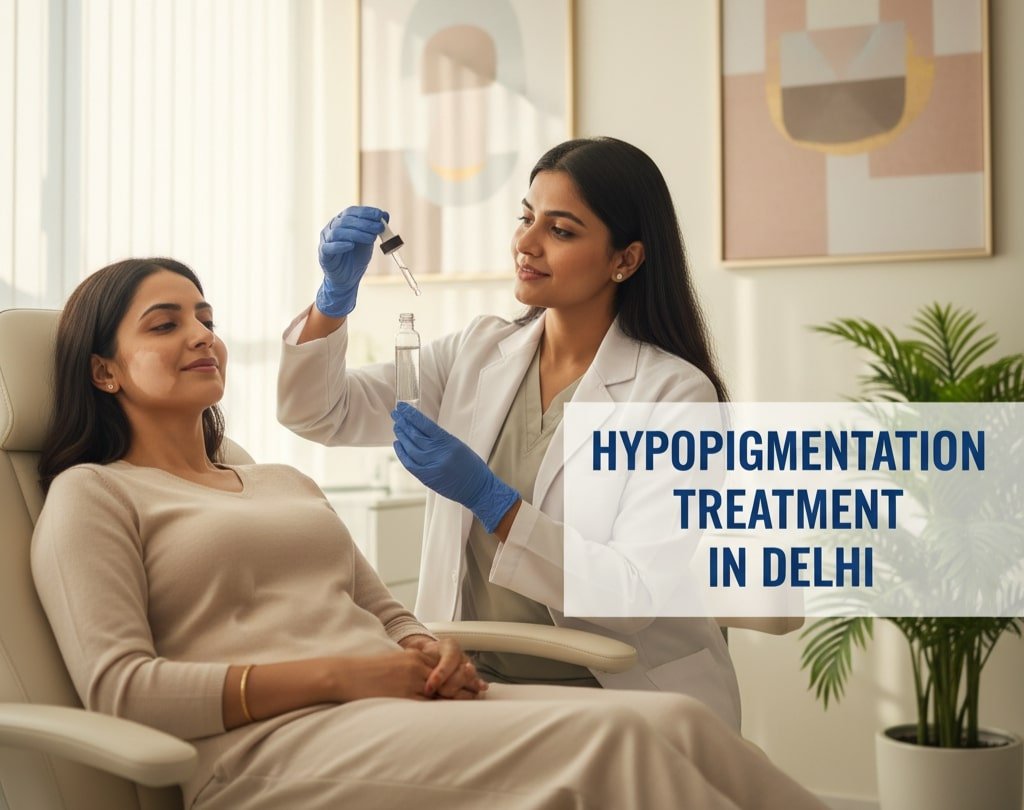Hypopigmentation—light or white patches that appear when the skin loses pigment—can be distressing, especially on the face or visible areas. If you are searching for hypopigmentation treatment in Delhi, this friendly, expert guide explains the best medical options, safe home measures, creams that dermatologists commonly use, and how to choose the best doctor for hypopigmentation treatment near you. The article also covers special advice for darker or black skin tones and practical answers to common questions.
What is hypopigmentation and why does it happen?
Hypopigmentation occurs when melanocytes (the cells that make pigment) are reduced or inactive in a patch of skin. Common causes include:
- Post-inflammatory loss of pigment after injury, burns, or infections
- Certain skin conditions (e.g., pityriasis alba, post-burn changes)
- Vitiligo (autoimmune loss of pigment) and other localized pigment disorders
- Scarring after surgery, laser, or deep skin infections
Accurate diagnosis is the first step to the best hypopigmentation treatment, because options differ if pigment cells are absent versus temporarily inactive.
How do dermatologists treat hypopigmentation?
Treatment depends on the cause, location, and depth of pigment loss. Common approaches used by dermatologists include:
1. Medical therapies to stimulate repigmentation
- Topical agents (prescribed creams that may include retinoids or other melanocyte-stimulating components) are often first-line when pigment cells are still present but inactive.
- Topical tacrolimus or calcineurin inhibitors are sometimes used on facial areas to encourage repigmentation with fewer steroid side effects.
- Oral medications may be considered in specific cases under specialist supervision.
2. Light-based and procedural options
- Targeted phototherapy (e.g., Excimer laser, narrowband UVB) can help stimulate melanocyte activity in many patients and is commonly used for localized hypopigmentation.
- Microneedling combined with topical therapies can improve delivery of active agents and support repigmentation.
- Surgical grafting or cellular transplantation is an option for stable, well-defined areas where pigment cells are absent — this includes grafting techniques that transplant pigment-producing cells into the affected area.
3. Camouflage and cosmetic solutions
- While medical treatment proceeds, medical-grade concealers, color correctors and tinted sunscreens are invaluable to improve appearance and confidence, especially for facial patches.
How to treat hypopigmentation on the face — practical steps
- Consult a dermatologist for accurate diagnosis and to rule out progressive conditions such as vitiligo.
- Start with topical medical therapy if the dermatologist recommends it, and follow the regimen consistently.
- Consider targeted phototherapy if topical therapy alone is slow or ineffective.
- Explore grafting only for stable, long-standing patches and after specialist evaluation.
- Use camouflage for social or professional confidence while treatment takes effect.
Hypopigmentation treatment cream — what to expect
There is no single over-the-counter cream guaranteed to restore pigment. Dermatologists typically prescribe targeted creams based on the cause:
- Prescription retinoids (to boost cell turnover) and calcineurin inhibitors (on delicate facial skin) are commonly used.
- Creams that claim “instant” repigmentation are often cosmetic tints — temporary solutions rather than medical cures.
Always use creams under dermatologist guidance to avoid irritation that could worsen pigment loss.
Hypopigmentation treatment at home — safe practices
- Protect treated areas from sun using broad-spectrum sunscreen; sun can deepen surrounding skin and make hypopigmented patches more visible.
- Avoid harsh DIY bleaching or abrasive peels — these can damage skin and worsen pigment problems.
- Follow your dermatologist’s topical schedule and attend follow-up visits regularly.
- Use gentle skincare (mild cleansers, moisturisers) to support healing.
Hypopigmentation treatment for black skin — special considerations
Treating hypopigmentation on darker skin tones requires extra care:
- Conservative, stepwise treatments reduce the risk of new pigment problems (like post-inflammatory hyperpigmentation).
- Some lasers and aggressive peels that work on lighter skin may cause harm on black skin; your dermatologist will tailor procedures and settings.
- Microneedling, targeted phototherapy, and carefully chosen topical agents are often preferred starting points.
People Also Ask — short, SEO-ready answers
How to treat hypopigmentation at home?
Home measures include sunscreen, gentle skincare, camouflage cosmetics, and following any dermatologist-prescribed topical treatment. Do not attempt aggressive home peels or bleachings.
What cream is good for hypopigmentation?
There’s no universal OTC cure. Dermatologists often prescribe retinoid-based creams or topical calcineurin inhibitors for facial hypopigmentation; these require medical supervision.
Can vitamin C treat hypopigmentation?
Topical vitamin C brightens overall skin tone and supports repair but is not a primary treatment for hypopigmentation. It may be a helpful adjunct alongside specialist-prescribed therapies.
How to find the best doctor for hypopigmentation treatment in Delhi
Look for a dermatologist who:
- Has experience with pigment disorders and treatments for darker skin tones.
- Offers in-clinic phototherapy and procedural options (microneedling, grafting) if needed.
- Provides realistic counselling about timelines, likely outcomes and maintenance.
Search phrases like hypopigmentation treatment in South Delhi, hypopigmentation treatment in West Delhi, hypopigmentation treatment near me, and best dermatologist for hypopigmentation treatment will help you locate local specialists with the right expertise.
Local care — Sunshine Skin Clinic (Dr. Namrata Ghai)
For personalised hypopigmentation treatment in Delhi, consult Dr. Namrata Ghai at Sunshine Skin Clinic. With 21 years of clinical experience, Dr. Namrata offers accurate diagnosis, tailored topical plans, targeted phototherapy, grafting options for stable patches, and expert care for darker skin tones.
Clinic addresses & contact:
- West Delhi (Bali Nagar): 52, Block H, Bali Nagar, New Delhi, 110015 — (Sunday off). Phone: 9818246660
- South Delhi (Safdarjung Enclave / Krishna Nagar): B-3/97, Krishna Nagar, Safdarjung Enclave, New Delhi, 110029 — (Tuesday off).
- Appointments / enquiries: 8860760770 — Email: doctor.namo@gmail.com
Bring photos, a brief history of the patch, and any past treatment records to your first consultation.


